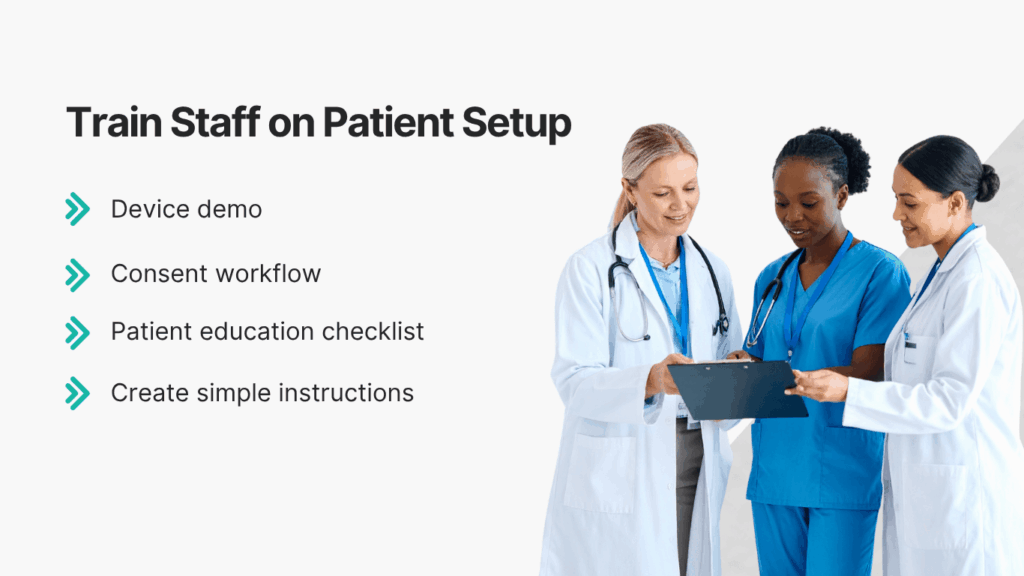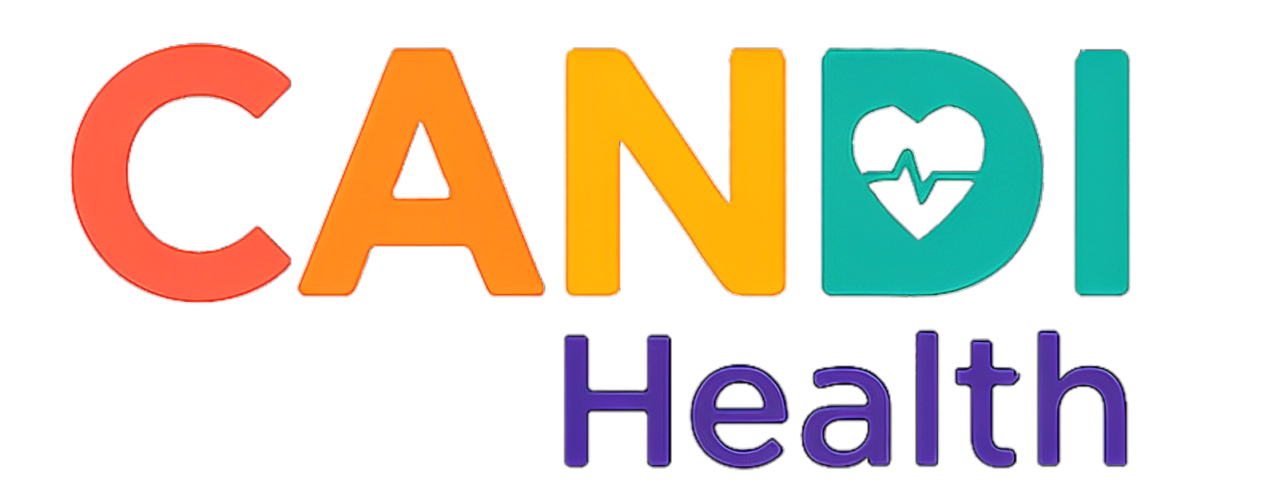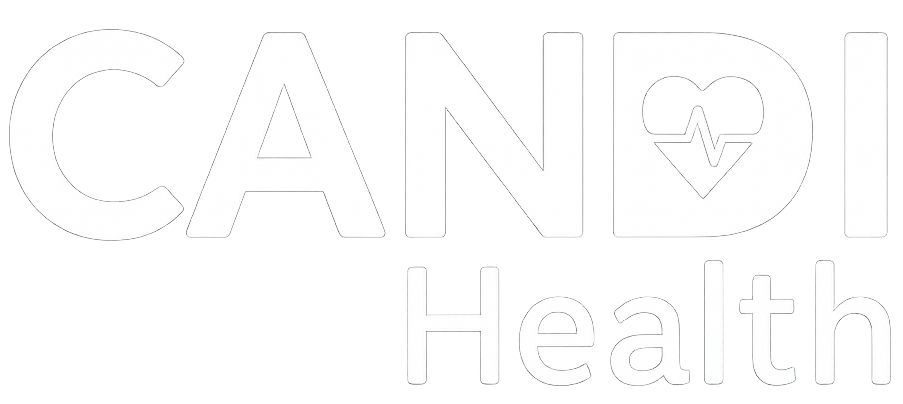Remote Patient Monitoring (RPM) works only when your staff knows how to run it well. Good training helps your team read patient data correctly, handle alerts fast, and keep patients active in the program.
This matters because almost 50% of patients in RPM programs stop using their device within the first 30 days if the workflow is unclear (Source: CDC).
Most clinics struggle because their team is busy, unsure where to start, or not confident with new tools. But with the right training plan, your staff can manage RPM with ease, support more patients, and improve outcomes.
In this guide, you’ll learn how to train your staff for RPM success using clear, simple steps. Each section shows what your team needs to know, from device setup to alert handling, so you can build a smooth, strong workflow.
CandiHealth also makes this easier with simple tools, clear alerts, and an easy dashboard your team can learn in minutes, not weeks.
How to Train Your Staff for RPM Success?
To train your staff for RPM success, teach them the basics of device use, build a clear workflow, set alert rules, give them simple call scripts, and provide ongoing training. When your team knows what to do each day, RPM becomes easy to run and patients stay more engaged. Here are the details on how to train your staff for RPM success.
1. Teach the Basics of RPM
Start by helping your staff understand what RPM does and why it matters. Your team should know how the device works, how readings move to the dashboard, and what each alert means. This simple knowledge builds confidence.
Research shows that clinics with trained staff see 35% fewer missed readings (Source: AHA). When your team understands the basics, they can guide patients better and avoid early drop-off.
2. Train Staff on Patient Setup
A strong RPM program starts with a smooth patient setup. Your staff should feel confident when guiding patients through device use and first readings. Clear teaching at this stage helps reduce confusion and keeps patients active in the program. Here are the key steps for patient setup:

- Device demo: Show how to use the BP device, how to take a reading, and what each sign on the screen means.
- Consent workflow: Make sure the patient signs the needed forms and understands how their data is shared with the clinic.
- Patient education Checklist:
- When to take readings
- How often to use the device
- What to do if they see a high or low reading
- Who to call if they have questions
- Create simple instructions: Give patients a short one-page guide they can keep at home.
- Avoid Common Mistakes:
- Not checking cuff size
- Not explaining posture during readings
- Forgetting to confirm the patient’s first test reading
When staff follow the same steps with every patient, setup becomes faster, easier, and more consistent across your clinic.
3. Build a Simple RPM Workflow for Your Team
A clear workflow helps your staff know what to do each day. It also keeps readings organized and prevents missed alerts. Your team should have set tasks for each part of the week so nothing slips through the cracks.
| Task Type | Who Does It | What They Do |
| Daily Tasks | Nurse / MA | Check alerts, review new readings, note any red flags, call patients with urgent issues. |
| Weekly Tasks | Nurse / MA | Check inactive patients, review low-reading counts, follow up with patients who missed readings. |
| Monthly Tasks | Doctor | Review patient trends, adjust treatment, update care plans, and confirm RPM goals. |
Why This Workflow Helps
- Gives staff a clear routine
- Helps catch issues faster
- Reduces patient drop-off
- Keeps reports clean and ready for review
When your team follows a simple workflow like this, RPM becomes easy to manage—even for busy clinics.
4. Focus on Alert Management
Alert management is one of the most important skills your staff must learn. Your team should know which alerts need a fast response, which ones need a simple check-in, and how to speak with patients when readings look high or low. Clear alert rules help keep patients safe and reduce stress for your staff. What Staff Should Know
- How to read systolic and diastolic values
- What counts as high, low, or normal (based on AHA ranges)
- Which alerts need a call right away
- When to notify the doctor
- How to record each action
A patient sends a 165/102 reading. The MA checks the dashboard, calls the patient within a few minutes, confirms they took the reading in the right posture, asks about symptoms, and logs the note. If the patient reports headache or chest pain, the MA alerts the doctor at once. This quick response improves safety and builds trust with the patient. Clear alert training helps staff act with confidence and prevents missed risks.
5. Train Staff on Documentation and Billing
Clear documentation helps your clinic stay organized and avoid mistakes. Your team should know how to record readings, note patient calls, and follow simple billing steps. Good notes also help doctors review care plans faster.
| What to Record | Why It Matters | Who Does It |
| Daily Notes | Tracks alerts, symptoms, and follow-ups | Nurse / MA |
| Patient Call Logs | Shows what was discussed and what to do next | Nurse / MA |
| Missed Readings | Helps find patients who need help with the device | Nurse / MA |
| Monthly Review Notes | Helps doctor adjust treatment and confirm progress | Doctor |
| Billing Support Notes | Ensures clean CPT submissions without missing data | Nurse / MA |
Keep It Simple
- Use short notes.
- Log every call or alert action.
- Make sure readings are linked to the right patient.
- Keep monthly summaries ready for the doctor.
When your team documents the same way every time, the RPM program stays clean, clear, and ready for smooth billing.
6. Provide Ongoing Training
RPM is not a “train once and forget” system. Your staff needs simple, regular refreshers so they stay confident, catch issues early, and keep patients on track. Ongoing training also helps your team follow the same workflow even when new staff join. Easy ways to keep training active:
- Monthly Check-Ins: Review alerts, patient trends, and common issues.
- Weekly Huddles: Discuss missed readings, repeat alerts, and simple fixes.
- Short Refresher Guides: Share quick notes on posture, cuff placement, or alert rules.
- Dashboard Updates: Show any new features that make work smoother.
- Role Practice: Let staff practice calls together for 5–10 minutes each week.
Simple, steady training keeps your RPM program running strong without adding extra pressure on your staff.
How CandiHealth Helps Your Team Succeed
A strong RPM program needs tools that are easy for staff to learn and simple for patients to use. CandiHealth makes this process smooth by removing the technical barriers that often slow clinics down.
Why Clinics Find CandiHealth Easy to Train
- Simple Dashboard: Your staff can learn it in minutes. All readings, alerts, and patient details appear in one clean view.
- Clear Alerts: The system highlights high or low readings so your team knows what to handle first.
- No App or Wi-Fi Needed: Patients use pre-configured cellular BP devices. This reduces support calls and makes staff training easier.
- Easy Setup: Staff can enroll a patient in under a minute, which keeps your workflow fast.
- Less Work for Your Team: Automated reading uploads mean your staff spends more time helping patients and less time troubleshooting devices.
Want to see how your team can run RPM with less effort? Book a short demo with CandiHealth and try the workflow for yourself.
Frequently Asked Questions (FAQs)
How long does it take to train staff for RPM?
Most clinics train their team in 1–2 hours when the workflow is simple. A short weekly refresher keeps everyone aligned and helps new staff learn fast.
Do medical assistants need special skills for RPM?
No. MAs only need basic training on alerts, reading trends, and patient calls. With a clear script and simple dashboard, they can manage RPM with ease.
What is the most important part of RPM training?
The most important part is alert management. Staff must know which readings are urgent, when to call a patient, and when to notify the doctor. Clear alert rules prevent delays and improve patient safety.
How often should clinics retrain their staff?
A short refresher every 2–4 weeks works best. It keeps the team confident, reduces mistakes, and helps everyone follow the same workflow.
What training materials should clinics prepare?
You only need simple items:
- A one-page alert guide
- Basic call scripts
- A workflow chart
- A short device guide for patients
These tools make training faster and more consistent.
Do staff need to understand CPT codes?
Only at a basic level. Staff should know what data to record and why, but they don’t need deep billing knowledge. Clear documentation helps the billing team submit clean claims.






